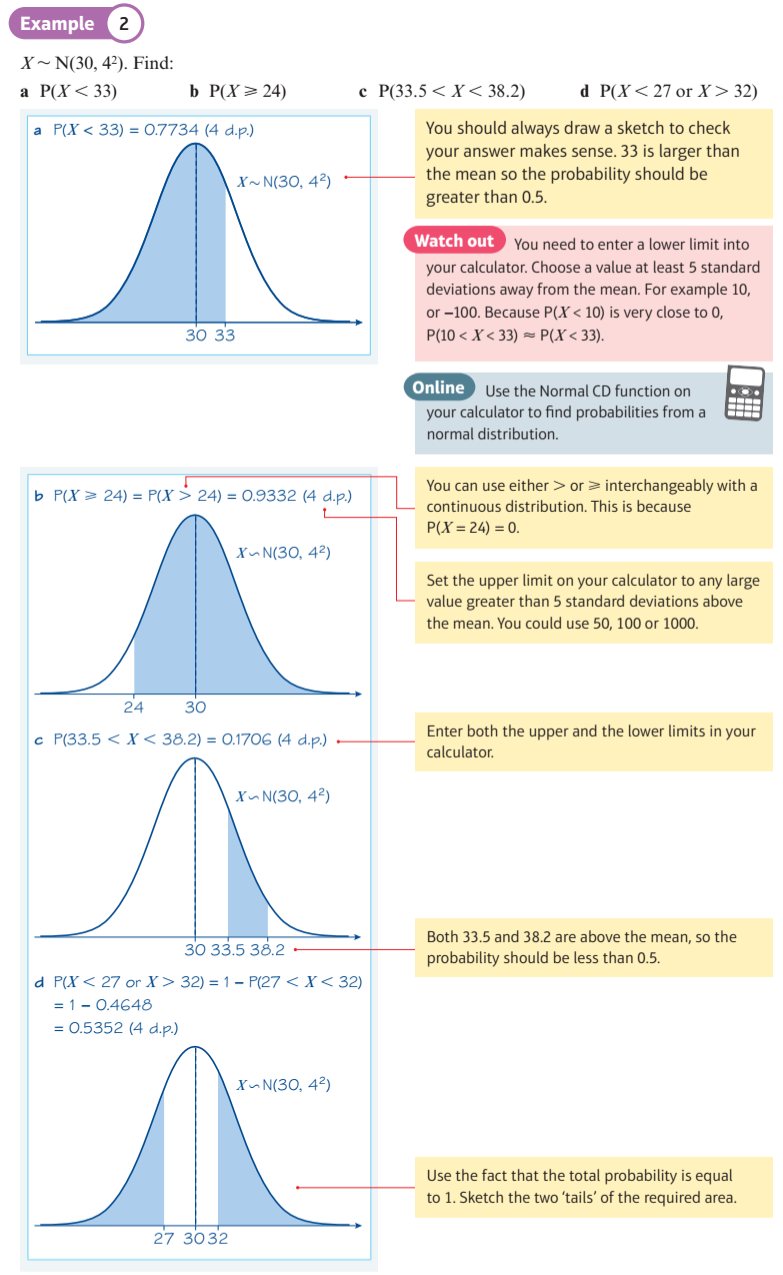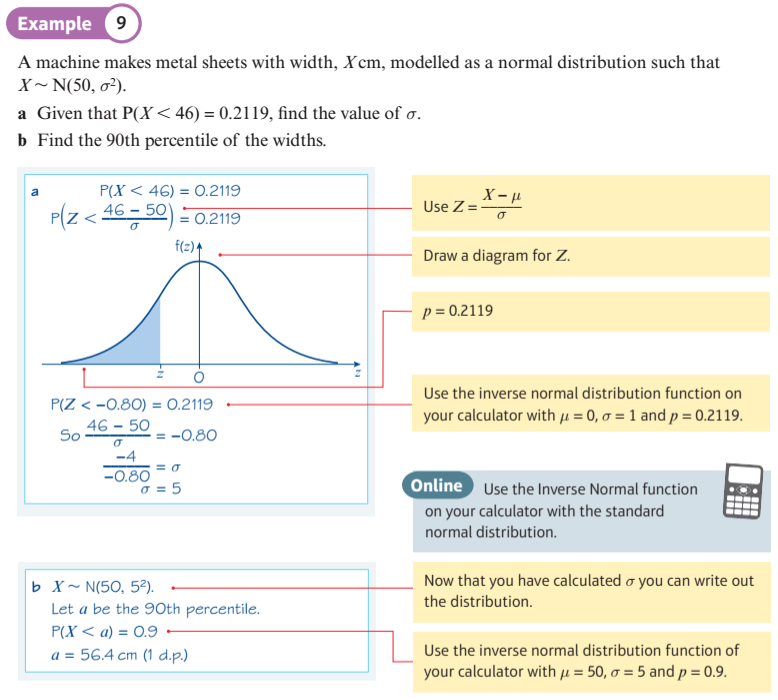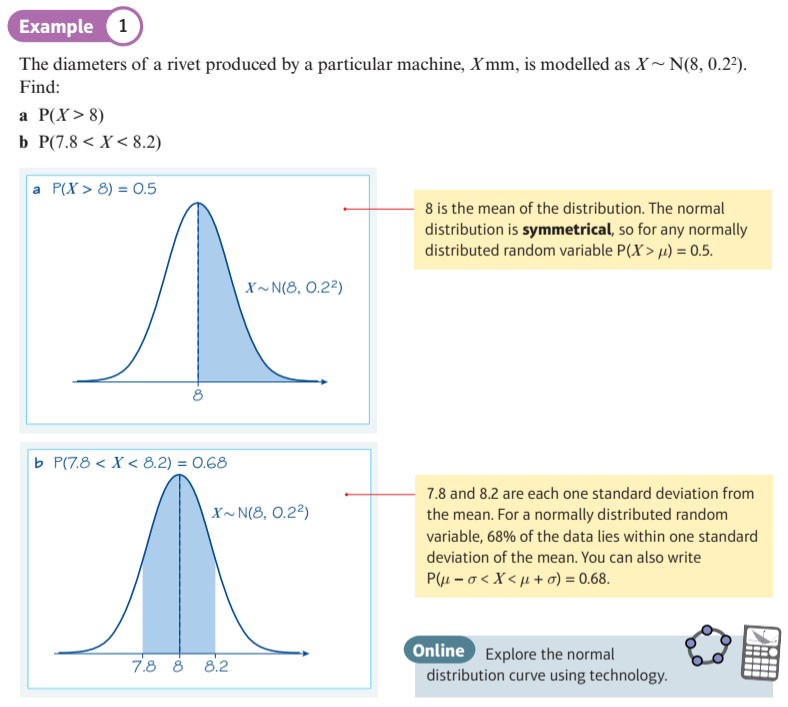
Use the Normal Cumulative Distribution (CD) function

Use the Inverse Normal function

Use the Inverse Normal function with the Standard Normal distribution

Explore the Normal distribution

The Normal Distribution
The normal curve was developed in 1733 by DeMoivre as an approximation to the binomial distribution.
His paper was not discovered until 1924 by Karl Pearson.
Laplace used the normal curve in 1783 to describe the distribution of errors.
Subsequently, Gauss used the normal curve to analyze astronomical data in 1809.
The normal curve is often called the Gaussian distribution.
The term bell-shaped curve is often used in everyday usage.
The shape of the normal distribution is determined by two parameters, the mean $\color{blue}{ \mu }$ and the variance $\color{blue}{ { \sigma ^ 2 } }$, and a Normally distributed random variable $\color{blue}{ X }$ is commonly denoted $\color{blue}{ X \sim N(\mu , { \sigma ^ 2 } ) }$.
In the display below you can see the effects of changing the mean and the standard deviation (the square root of the variance).
After selecting "Show Probability", you can also slide the two gliders on the x-axis to see the probability that $\color{blue}{ X }$ falls between them.
The shape of the normal distribution is determined by two parameters, the mean $\color{blue}{ \mu }$ and the variance $\color{blue}{ { \sigma ^ 2 } }$, and a Normally distributed random variable $\color{blue}{ X }$ is commonly denoted $\color{blue}{ X \sim N(\mu , { \sigma ^ 2 } ) }$.
In the display below you can see the effects of changing the mean and the standard deviation (the square root of the variance).
After selecting "Show Probability", you can also slide the two gliders on the x-axis to see the probability that $\color{blue}{ X }$ falls between them.
Standardising Normal Variables
The 'Standard' Normal distribution is a special case of the Normal distribution with mean, 0 and standard distribution, 1.
The 'Standard' Normal distribution is commonly denoted $\color{green}{ Z \sim N( 0 , { 1 ^ 2 } ) }$.
It would not be possible to provide look-up tables for the probabilities associated with the infinite number of general Normal distributions, but it is possible to provide look-up tables for the Standard Normal distribution. Calculators can also provide probabilities for the Standard Normal distribution. The common practice is to transform, or "standardise", general Normal variables to Standard normal variables, for which look-up tables and calculator functions are available. The transformation may be reversed at the end, if required.
This display allows you to see how the transformation works. You can model a general Normal distribution, $\color{blue}{ X \sim N(\mu , { \sigma ^ 2 } ) }$, and transform it to Y by altering parameters a and b. You should see the required transformation formula when the Y distribution matches the Z distribution.
After selecting "Show Probability", you can also slide the two gliders on the x-axis to see the probability that $\color{blue}{ X }$ falls between them.
It would not be possible to provide look-up tables for the probabilities associated with the infinite number of general Normal distributions, but it is possible to provide look-up tables for the Standard Normal distribution. Calculators can also provide probabilities for the Standard Normal distribution. The common practice is to transform, or "standardise", general Normal variables to Standard normal variables, for which look-up tables and calculator functions are available. The transformation may be reversed at the end, if required.
This display allows you to see how the transformation works. You can model a general Normal distribution, $\color{blue}{ X \sim N(\mu , { \sigma ^ 2 } ) }$, and transform it to Y by altering parameters a and b. You should see the required transformation formula when the Y distribution matches the Z distribution.
After selecting "Show Probability", you can also slide the two gliders on the x-axis to see the probability that $\color{blue}{ X }$ falls between them.
Skewed Normal Distribution
The normal curve was developed in 1733 by DeMoivre as an approximation to the binomial distribution.
His paper was not discovered until 1924 by Karl Pearson.
Laplace used the normal curve in 1783 to describe the distribution of errors.
Subsequently, Gauss used the normal curve to analyze astronomical data in 1809.
The normal curve is often called the Gaussian distribution.
The term bell-shaped curve is often used in everyday usage.
The shape of the normal distribution is determined by two parameters, the mean $\color{blue}{ \mu }$ and the variance $\color{blue}{ { \sigma ^ 2 } }$, and a Normally distributed random variable $\color{blue}{ X }$ is commonly denoted $\color{blue}{ X \sim N(\mu , { \sigma ^ 2 } ) }$.
In the display below you can see the effects of changing the mean and the standard deviation (the square root of the variance).
After selecting "Show Probability", you can also slide the two gliders on the x-axis to see the probability that $\color{blue}{ X }$ falls between them.
The shape of the normal distribution is determined by two parameters, the mean $\color{blue}{ \mu }$ and the variance $\color{blue}{ { \sigma ^ 2 } }$, and a Normally distributed random variable $\color{blue}{ X }$ is commonly denoted $\color{blue}{ X \sim N(\mu , { \sigma ^ 2 } ) }$.
In the display below you can see the effects of changing the mean and the standard deviation (the square root of the variance).
After selecting "Show Probability", you can also slide the two gliders on the x-axis to see the probability that $\color{blue}{ X }$ falls between them.
